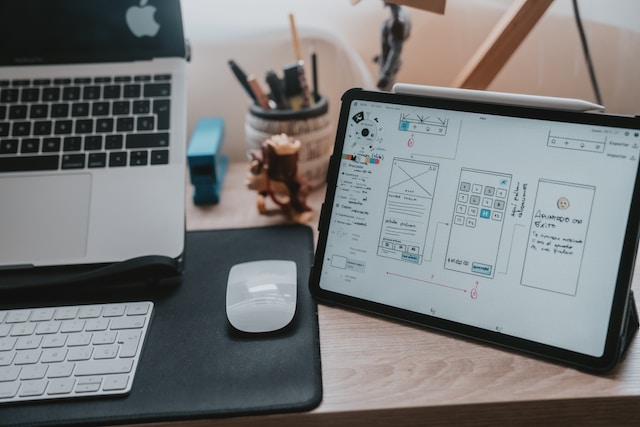In the evolving digital design world, UX (User Experience) research plays a key role in creating products that users want to use repeatedly. Without it, designing is like working in the dark — you’re basically guessing, and that’s not a solid plan for creating user-centered products. So, let’s explore the UX research process. Dive deeper into the stages, methods, and tools that equip designers to craft products that exceed user expectations.

What Is UX Research?
At its core, UX research involves strategic approaches to design and development to deeply understand and improve the interactions between users and products. Using various research methods, such as interviewing and usability testing, UX researchers uncover why users do what they do and what they prefer.
The insights from research allow designers to create products that “wow” the users. Also, research remains an ongoing process as a product develops and evolves. Any skilled designer must practice user research to craft user-centered experiences, so let’s go over the key goals of UX research.
Key Goals of UX Research
UX research does not focus on making things look pretty, but it involves digging deep to understand the whys and hows of user behavior. One key goal of UX research involves identifying user needs and pain points. Discover these through interviews, usability testing, and more.
Another key goal of UX research is to improve usability and accessibility. For example, you don’t want to assume that users know what each icon means in your app. Do your research and test to see what may need improvement. Lastly, enhancing user satisfaction and loyalty is another key goal of UX research. Again, if you utilize the insights you learn from research, you can improve your product to increase user loyalty.

How To Build a UX Research Process: 4 Stages
We can all acknowledge the importance and usefulness of UX research. How can we conduct research that contributes to building strong user-centered products? Let’s look at the 4 stages of the UX research process so you can lead effective research.
1. Planning Phase
A crucial first step in the UX research process involves planning for strong research. Think of this stage as the architect’s blueprint before building something epic. Start by defining your objectives and goals. Figure out what exactly you want to discover about your users.
Let’s use a mobile banking app as an example. While there are numerous aspects to potentially improve the app, setting an objective and goal will help you focus your research. For example:
- Objective: “Understand user behaviors and pain points in the account management feature of the mobile banking app.”
- Goal: “Identify common user challenges in transferring funds between accounts and explore opportunities to streamline the process for increased user satisfaction.”
This objective and goal provide a clear focus for the research. It aims to uncover specific insights that can guide improvements in the management feature of the app.
Once you define your objectives and goals, you can write out your research plan. You want to include which user groups are the target and the best methods to reach them. Creating a research plan serves as a roadmap, outlining the objectives, methods, and timeline for the research study.
2. Data Collection
After thoroughly planning your research, it is time to gather information through various methods. They might already be in your research plan. Depending on the objectives and goals of your research, you may use several different research methods or just a couple.
User interviews allow you to hear the stories of users, which lets you peer into their thoughts and behaviors. Surveys and questionnaires may help cast a wider net and capture quantitative data to identify trends. Usability testing lets you observe users in action to spot friction points and areas for design improvement. Gathering analytics data is also an effective way to gain quantitative insights about user interactions.
Whatever method a UX researcher might take, it is about mixing qualitative and quantitative methods to comprehensively understand the user’s journey. The more data you have, the clearer picture you have of your users to lead your design solutions.
For the mobile banking app example, you should conduct a moderated usability test to see what issues users encounter when transferring funds between accounts. Also, you can get qualitative data by asking questions and hearing user stories about their experiences using the account management feature of the app. Looking at analytics can also provide a more comprehensive understanding of the user experience.
3. Data Analysis
Data analysis in the UX research process transforms raw data into actionable insights. Once researchers complete data collection, they synthesize the information and identify patterns and key findings. This phase might look like a lot of sticky notes of what users have said. It might be looking at the numbers and deciphering what they mean. By looking at qualitative data and quantitative data together, researchers are able to pull out actionable suggestions that guide design improvements. Using the insights and translating them into design decisions is the key part of this phase.
4. Reporting and Documentation
We’ve gathered a lot of information through research, and now it is time to consolidate findings, insights, and recommendations into comprehensive reports. These reports need to clearly articulate the user journey and key discoveries to the stakeholders and team. Incorporating visuals like charts, graphs, and personas enhances clarity. Documentation serves as a valuable reference that really captures user feedback and research outcomes. These detailed documents allow everyone to understand user needs, challenges, and the actions we must take to solve these problems. Referencing the reports and documents throughout the design process reminds you of the goals of your project. It also outlines your actions and keeps you grounded in data instead of assumptions.

Exploring Effective UX Research Methods
We went through the four stages of the UX research process. Now, let’s look at some effective UX research methods to use during your research.
Qualitative Methods
Qualitative research methods help you understand the “why” behind user behaviors. With this approach, you can also ask clarifying questions to get a richer understanding of what a user may be talking about. Here are some qualitative methods:
- User Interviews: Researchers get to speak with users or participants one-on-one, allowing for deep insights into motivations, preferences, and pain points. These conversations provide reasons behind user behaviors.
- Focus Groups: This method can uncover shared perspectives. Group discussions also offer a more interactive exploration of user opinions and attitudes.
- Contextual Inquiry: Getting a chance to observe users in their natural environment provides a lot of contextual data. You get to see how users interact with products in their daily lives.
Quantitative Methods
Quantitative methods help put numbers to the usability of your product. It also gives you benchmark data to see how much your design has improved. Compare an old design with a new design using some of these quantitative research methods:
- Surveys and Questionnaires: Surveys and questionnaires offer the benefit of allowing you to gather data from a larger audience. This helps identify trends and patterns by giving you a statistical perspective on user preferences and opinions.
- A/B Testing: This method compares two or more versions of a design to see which performs better. Having the numbers provides concrete evidence of why one design might be better than another.
- Analytics and Metrics Analysis: Using tools like Google Analytics provides quantitative data on user interactions and behavior, which informs decisions based on usage patterns.
Mixed-Methods Approach
Just as the word implies, the mixed-methods approach combines both qualitative and quantitative methods. Many researchers combine several methods to have a more holistic understanding. For example, pairing user interviews with surveys helps researchers have a fuller picture of user experience by understanding the numbers.
So, how do you pick the right research method? These are all effective methods, but which to utilize depends on the specific goals of a project. Keep in mind that a combination of user research methods helps give you a more comprehensive understanding of user experiences. Sharpen your research skills and learn more about UX research methods for better UX design.

Essential UX Research Tools
Along with knowing the research process and different research methods, it helps to know UX research tools that make research more efficient. Use these tools to your advantage to help collect, analyze, and interpret data in your research.
User Testing Platforms
Remote usability testing is an efficient method to reach a larger audience, and luckily, many platforms such as Usertesting.com and Maze help you gather data as you moderate your usability test.
Survey and Questionnaire Tools
SurveyMonkey and Typeform make it easy to create and distribute surveys. You can collect quantitative data and gather user opinions from a large pool of participants.

Analytics Platforms
Google Analytics and Hotjar provide in-depth insights into user behavior on websites and apps. Researchers use metrics such as page views, bounce rates, and user paths to understand user interactions better.
Prototyping Tools
Figma, Sketch, and Adobe XD bring wireframes to life for efficient prototyping. These tools aid researchers to test and refine designs before full implementation.
Collaboration Platforms
Platforms such as Figma and Miro make it easy to collaborate with designers and teams. Check out FigJam’s new AI feature to help synthesize all those research notes or even aid in creating research questions.
Heatmap and Eye-Tracking tools
Viewing heatmaps or tracking user eye movements is another great way to collect quantitative data for your research. Using tools like Crazy Egg and Tobii eye trackers shows you where and how long users focus their attention. This can confirm a great design or aid in iterating a certain aspect of your design.
Remote Research Platforms
Living in the digital age, researchers can use Zoom and Lookback to conduct remote interviews and usability testing. Again, this is a great way to get a diverse pool of participants for your research.
User Persona and Journey Mapping Tools
Xtensio and Smaply help you easily create user personas and journey maps based on your research. Keep these visual documents to ground design decisions on user pain points and needs.
Note-Taking and Analysis Tools
Speed up your analysis using tools like Dovetail to organize and analyze qualitative data. Data from user interviews and focus groups can be lengthy, but tools like Dovetail can help you arrive at meaningful insights faster.
Incorporating these essential tools in your UX research process will help you organize and analyze your data more efficiently.
UX Research Leads to User-Centric Designs
We covered the UX research process, explored various user research methods, and discussed essential tools to equip us to be better researchers. Starting from the planning phase to documentation, all these steps and methods bring us closer to a more user-centered design. Don’t forget to use tools to assist in collecting and synthesizing research data.
As you navigate the world of user experience, remember that continual improvement is key. Explore proven products for design inspiration at Page Flows, a valuable resource offering a growing library of user flow recordings. Elevate your user-centric approach, and begin your journey with Page Flows today!




